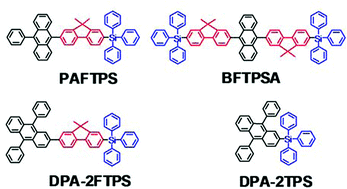Efficient deep-blue and white organic light-emitting diodes based on triphenylsilane-substituted anthracene derivatives
Abstract
A series of

* Corresponding authors
a
Department of Chemistry, Sungkyunkwan University, Suwon, Korea
E-mail:
ssyoon@skku.edu
Fax: +82 31 290 7075
Tel: +82 31 290 7071
b
Department of Information Display, Hongik University, Seoul, Korea
E-mail:
kimyk@hongik.ac.kr
Fax: +82 2 3141 8928
Tel: +82 2 3142 3750
A series of

 Please wait while we load your content...
Something went wrong. Try again?
Please wait while we load your content...
Something went wrong. Try again?
K. H. Lee, J. K. Park, J. H. Seo, S. W. Park, Y. S. Kim, Y. K. Kim and S. S. Yoon, J. Mater. Chem., 2011, 21, 13640 DOI: 10.1039/C1JM12097B
To request permission to reproduce material from this article, please go to the Copyright Clearance Center request page.
If you are an author contributing to an RSC publication, you do not need to request permission provided correct acknowledgement is given.
If you are the author of this article, you do not need to request permission to reproduce figures and diagrams provided correct acknowledgement is given. If you want to reproduce the whole article in a third-party publication (excluding your thesis/dissertation for which permission is not required) please go to the Copyright Clearance Center request page.
Read more about how to correctly acknowledge RSC content.
 Fetching data from CrossRef.
Fetching data from CrossRef.
This may take some time to load.
Loading related content
